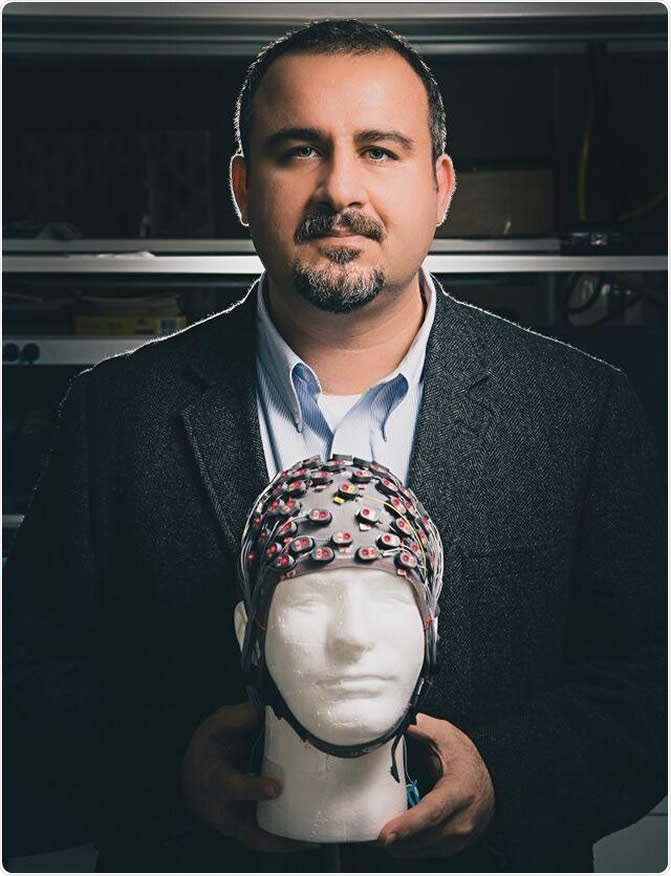A new study from the scientists at the University of Houston reveals specific neuromarkers for Parkinson’s disease. Deep brain stimulation for Parkinson’s disease could now be targeted towards cells carrying these markers in the brain and thus become more accurate and specific explain the researchers. The study titled, “Distinct subthalamic coupling in the ON state describes motor performance in Parkinson's disease,” was published in the latest issue of the Movement Disorders journal.
Parkinson’s disease affects around 10 million individuals across the globe and in the United States alone 60,000 people are diagnosed with this debilitating movement disorder every year. It is a degenerative disease of the brain that affects parts of the brain that are associated with normal movement and balance.

Nuri Ince, associate professor of biomedical engineering at the University of Houston. Image Credit: University of Houston
The classic symptoms of this condition are a tremor or shaking of the hand or other limbs while at rest. Another classic symptom is rigidity and increased tone in the body's muscles. The movements of the body are slowed (this is termed bradykinesia) and the patient often finds difficulty in maintaining balance.
Deep brain stimulation is a method by which high frequency stimulating waves are provided to the specific regions of the brain to treat neurodegenerative conditions including Parkinson’s disease. It is now been accepted as a well established therapy for the progressive nervous system disorders that alters and affects the movement and balance of the body. Till date the accuracy of deep brain stimulation has been a question mark. Further the stimulators used now are not adaptable to the changes in the symptoms and the functuations of the disease process. With the identification of these neuromarkers, the stimulation waves would now know which cells to target and thus could be called “smart” deep brain stimulators.
Nuri Ince, associate professor of biomedical engineering, a doctoral student to Musa Ozturk, lead author of the paper, in a statement said, “We can now make the closed-loop stimulator adaptive to sense a patient's symptoms, so it can make the adjustments to the fluctuations in real time, and the patient no longer has to wait for weeks or months until the doctor can adjust the device.”
The team used three weeks recordings in 9 patients with Parkinson’s disease and used two methods to assess the symptoms of the patients in the OFF and ON states, these were, “a subsection of the UPDRS and a keyboard tapping score measuring bradykinesia.” UPDRS is the universal scoring system for symptoms of Parkinson’s disease that is used to measure the progress of the patients.
In their study the team also noted the underlying electrophysiology of Parkinson's disease. They noticed the cross-frequency interactions between subthalamic nucleus of patients with Parkinson's disease. This was noted both when the patient was not on medication or in the OFF state and with medication for Parkinson’s disease or ON state. Although these interactions and coupling have been reported in previous studies, their significance was not known till now say the researchers. They explained that in the OFF state the coupling occurred between high-frequency brain wave oscillations (within range of 200-300Hz) and phase of low-beta (13-22Hz). This was noted in all patients. In the ON state however there were three different types of coupling one being between high-beta (22-30Hz) and high-frequency oscillations (range of 300-400Hz). In these patients the coupling resulted in improvement of symptoms such as slowness of movements or bradykinesia. Bradykinesia remains one of the main symptoms of Parkinsonism.
Ozturk explained, “Previous research showed coupling only existed in the basal ganglia of untreated patients and assumed to block the brain from functioning properly. We found that strong coupling also exists in treated patients, though at different frequencies, so in effect we have 'cleared coupling's name' and showed the frequencies involved in coupling impacts whether its effects are negative or positive.”
Authors of the study concluded, “Observing diminished coupling in the ON state, previous studies have hypothesized that the sole existence of coupling in STN has an “impeding” effect on normal processes, and thus it was considered to be pathological.” They added that their “observation of ON state coupling at distinct frequencies associated with the improvements in motor features suggest that the underlying mechanism of coupling might have impeding or enhancing effects depending on the coupled frequencies.”
The study was supported by the National Science Foundation and an “investigator‐initiated grant from Medtronic” declare the authors of the study.
Journal reference:
Ozturk, M. , Abosch, A. , Francis, D. , Wu, J. , Jimenez‐Shahed, J. and Ince, N. F. (2019), Distinct subthalamic coupling in the ON state describes motor performance in Parkinson's disease. Mov Disord. doi:10.1002/mds.27800, https://onlinelibrary.wiley.com/doi/abs/10.1002/mds.27800